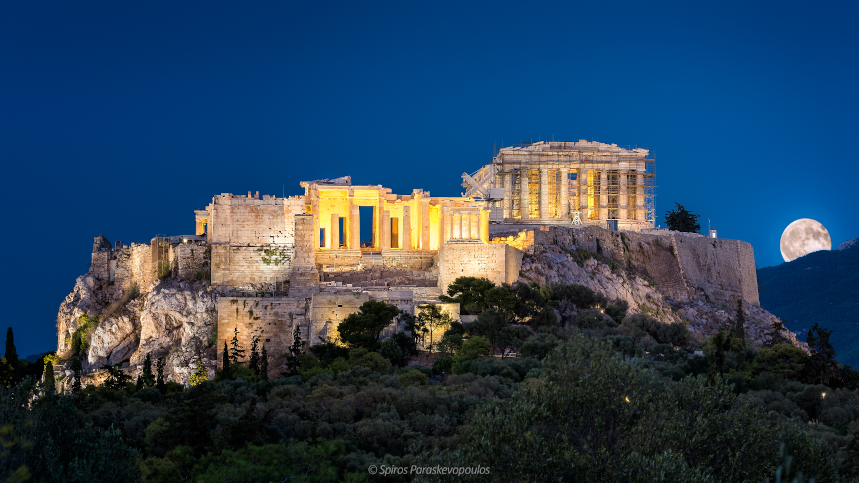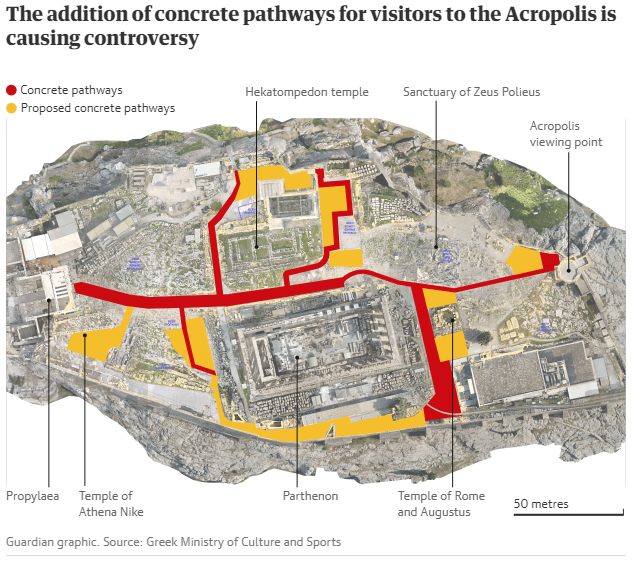
Submitted by Gregg Baldwin on Thu, 10/06/2021 - 13:21
On 28th April 2021, The Art Newspaper reported on planned alterations to the Acropolis. In article entitled, "Acropolis renovation plans spark accusations that it’s ‘just another way to fit in more tourists’," the paper states: " This latest renovation is intended to improve access and traffic management of visitors and, according to a statement from the ministry of culture, “remove erroneous interventions of the past”."
The plans involve laying new pathways in reinforced concrete over a significant area of the ancient site and were approved by the Committee for the Conservation of the Acropolis Monuments, an interdisciplinary body established in 1975 to oversee restoration works on the Acropolis. Plans obtained by The Guardian from the Minsitry of Culture and Sport show the extent of the proposed paths which were conceived by the architect leading the restoration efforts, Manolis Korres. In their article entitled "Acropolis now: Greeks outraged at concreting of ancient site," The Guardian quotes Korres: "“Any intervention raises the issue of aesthetics and is a controversial process. It’s always about weighing what is gained and what is lost.”
Reactions to the plans have, predictably, been fierce. The Art Newspaper reported: "In an open letter to the public, the signatories, including figures from the universities of Oxford, Durham and Brown, called for the cancellation of a project they believe will lead to the “devaluation, concealment and degradation of the greatest archaeological and artistic treasure that has been bequeathed to modern Greece”." And The Guardian reports: "Dr Tasos Tanoulas, until recently director of restorations at the Propylaia, also deplored the decision to cover so much of the rock’s face with reinforced concrete, saying the move would lead inexorably to “degradation of the natural landscape and a devaluation of the rock as a natural monument in its own right, as a natural fort”."
Even the leader of the opposition party Alex Tsipras has joined in, posting a video on YouTube in which he states; "the scale of the concrete intervention, which alters the landscape of a World Heritage site, and has provoked criticism by many scientists, a strong reaction by the public regardless of political orientation, and condemnation in the international press."
The paths continue a project begun last November and funded by The Onassis Foundation, to enable wheelchair users to access the site. That path was also constructed using reinforced concrete and stirred equally strong emotions. The Greek City Times quoted Greece’s Minister of Culture and Sports Lina Mendoni as saying: "It is an architectural concrete, the cement content of which is only 12%. A durable material is necessary, first, to facilitate the movement of wheelchairs." (from Making the Acropolis accessible.) She also claimed that 150 people each year fall on the uneven ground what many Greeks call the Sacred Rock, with many breaking a leg.
The debate continues to rage.
Header image: Spirosparas, CC BY-SA 4.0 <https://creativecommons.org/licenses/by-sa/4.0>, via Wikimedia Commons


